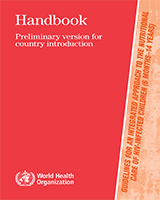All rights reserved. Publications of the World Health Organization can be obtained from WHO Press, World Health Organization, 20 Avenue Appia, 1211 Geneva 27, Switzerland (tel.: +41 22 791 3264; fax: +41 22 791 4857; e-mail: tni.ohw@sredrokoob). Requests for permission to reproduce or translate WHO publications – whether for sale or for noncommercial distribution – should be addressed to WHO Press, at the above address (fax: +41 22 791 4806; e-mail: tni.ohw@snoissimrep).
NCBI Bookshelf. A service of the National Library of Medicine, National Institutes of Health.
Overview
In the area of nutrition and HIV, children deserve special attention because of their additional needs to ensure growth and development and their dependency on adults for adequate care. It was therefore proposed to first develop guidelines for children and thereafter consider a similar approach for other specific groups.
The content of these guidelines acknowledges that wasting and undernutrition in HIV-infected children reflect a series of failures within the health system, the home and community and not just a biological process related to virus and host interactions. In trying to protect the nutritional well-being or reverse the undernutrition experienced by infected children, issues of food insecurity, food quantity and quality as well as absorption and digestion of nutrients are considered. Interventions are proposed that are practical and feasible in resource-poor settings and offer a prospect for clinical improvement.
The guidelines do not cover the feeding of infants 0 to 6 months old, because the specialised care in this age group is already addressed in other WHO guidelines and documents.
Contents
- Acknowledgement
- Acronyms
- Introduction
- SECTION 1. ASSESS, CLASSIFY AND DECIDE A NUTRITIONAL CARE PLAN
- Step 1. Assess and classify the child's growth
- Step 2. Assess the child's nutritional needs
- Step 3. Decide a Nutrition Care Plan
- Set Targets for Energy and Micronutrient Intakes
- Nutritional supplements to provide additional energy
- Therapeutic feeding for children with severe malnutrition
- When to change Nutritional Care plans
- Entry and exit criteria for nutritional supplements
- Entry and exit criteria for therapeutic feeding
- Nutrition Care Plan A for the child who is growing well ± ART
- Nutrition Care Plan B for the child with poor weight gain or increased nutritional needs
- Nutrition Care Plan C for the severely malnourished HIV-infected child
- SECTION 2. IMPLEMENT THE NUTRITION CARE PLAN
- SECTION 3. CHILDREN WITH SPECIAL NEEDS
- References
- Appendix I Staging criteria for children infected with HIV
- Appendix II Composition of different Therapeutic Feeding options
- Appendix III Home-based foods to increase energy intake
- Appendix IV Suggestion sheets to improve food intake
- Appendix V Guiding Principles for Complementary Feeding of the Breastfed Child (2003)
- Appendix VI Guiding principles for feeding non-breastfed children 6-24 months of age (2005)
- Appendix VII Five Keys to Safer Food
- Chart booklet
- Guide for local adaptation
The designations employed and the presentation of the material in this publication do not imply the expression of any opinion whatsoever on the part of the World Health Organization concerning the legal status of any country, territory, city or area or of its authorities, or concerning the delimitation of its frontiers or boundaries. Dotted lines on maps represent approximate border lines for which there may not yet be full agreement.
The mention of specific companies or of certain manufacturers' products does not imply that they are endorsed or recommended by the World Health Organization in preference to others of a similar nature that are not mentioned. Errors and omissions excepted, the names of proprietary products are distinguished by initial capital letters.
All reasonable precautions have been taken by the World Health Organization to verify the information contained in this publication. However, the published material is being distributed without warranty of any kind, either expressed or implied. The responsibility for the interpretation and use of the material lies with the reader. In no event shall the World Health Organization be liable for damages arising from its use.
